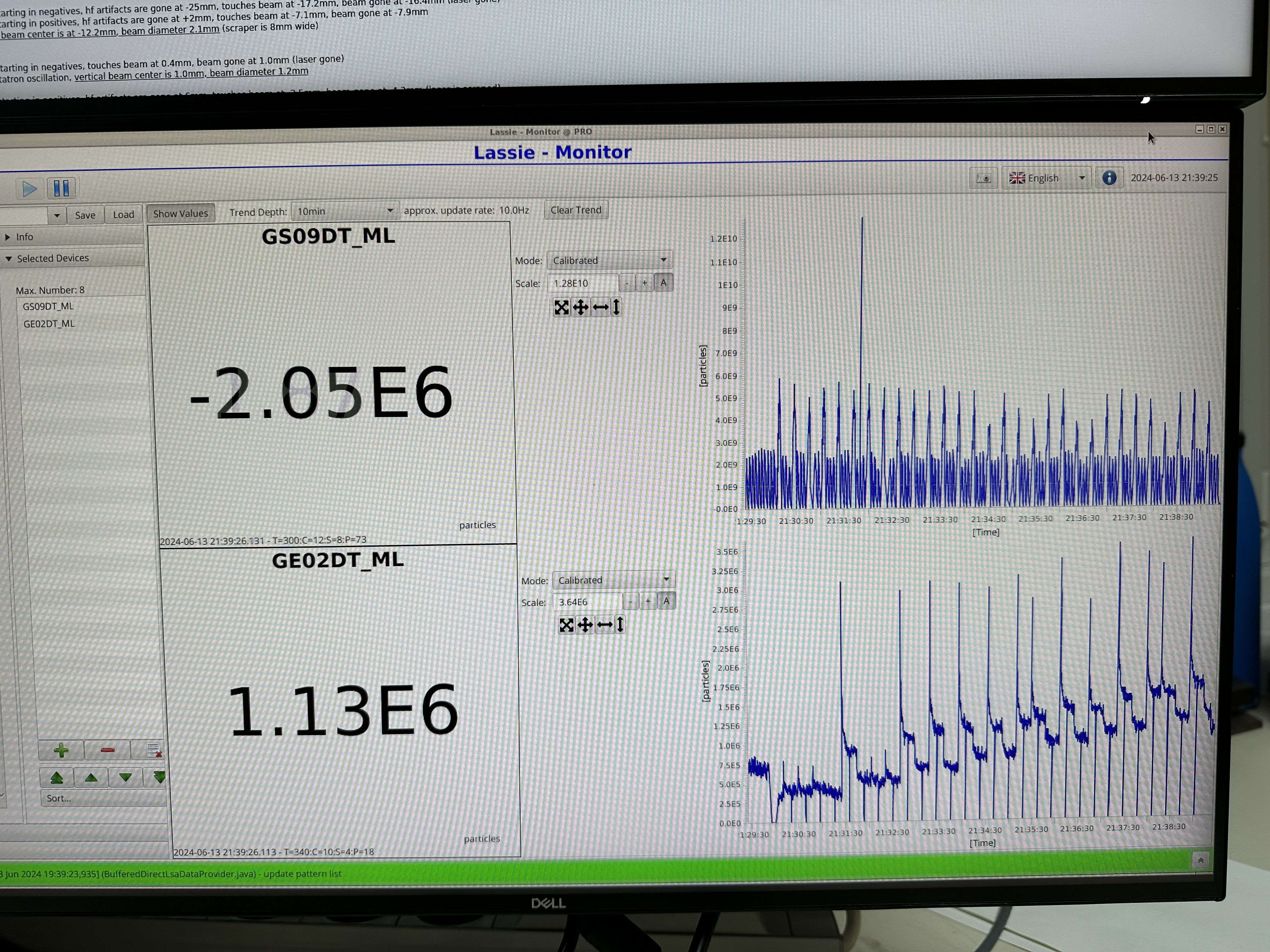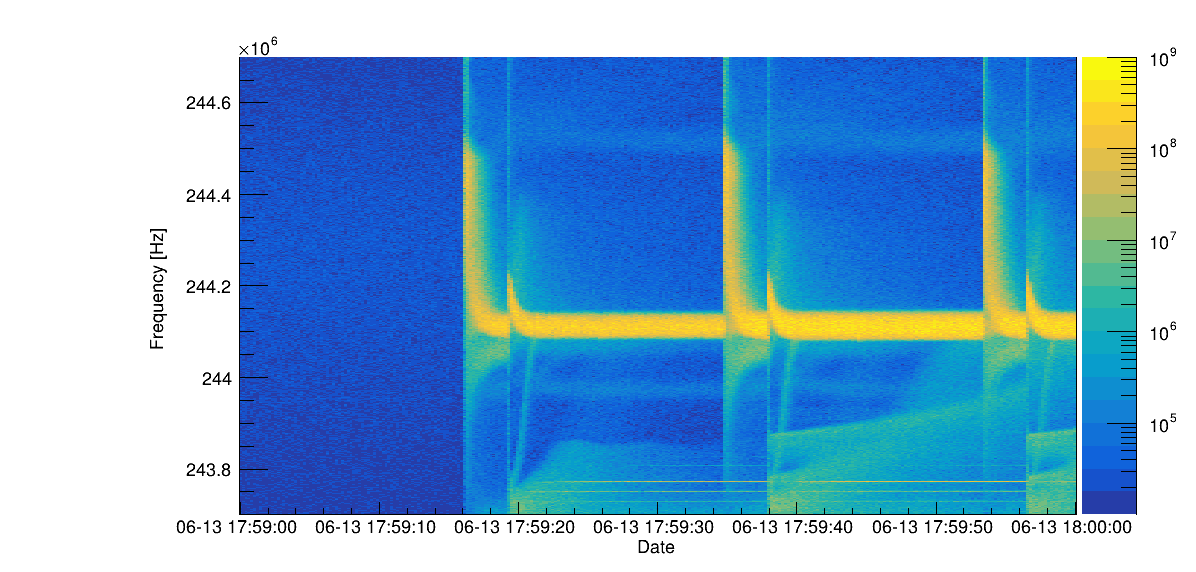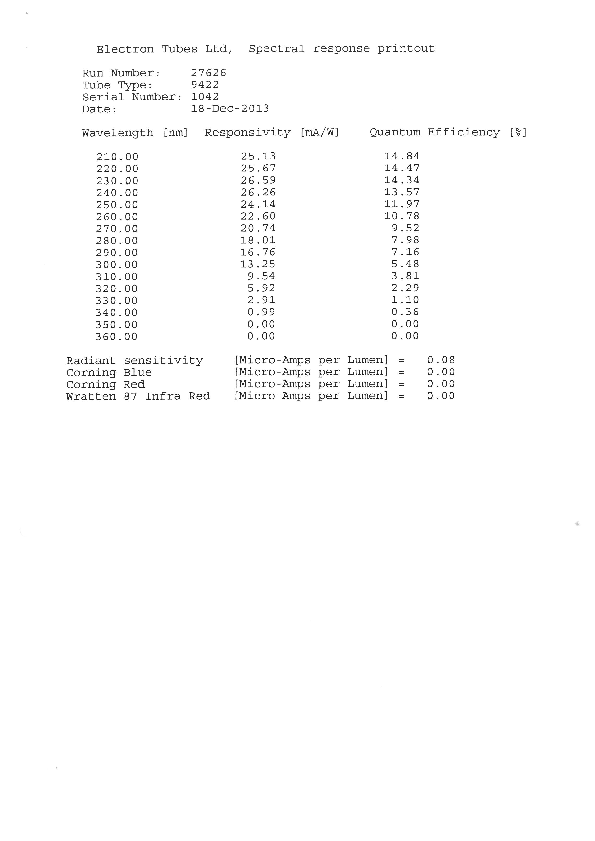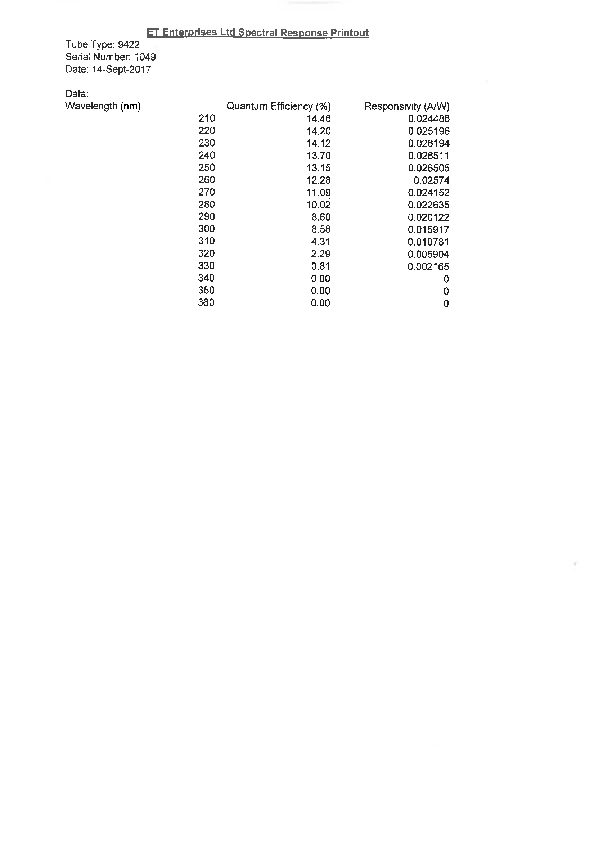| ID |
Date |
Author |
Category |
Subject |
|
57
|
Thu Jun 13 02:05:04 2024 |
Carsten | Accelerator | Short Lifetime at 100 mA |
Lifetime still is short |
| Attachment 1: 2024_06_13_229Th_Short_Lifetime3.png
|

|
|
69
|
Thu Jun 13 18:23:46 2024 |
Julian | Laser | Restarting the laser controller |
If the laser controller is locked up again, the little display will show an error message after an attempted medusa scan.
To restart it, follow these steps:
1.) Unlock the beam stabilization.
2.) shut down medusa and the wavemeter software
3.) Turn off the 2 laser stages
4.) Close the shutter of the pumping laser
5.) Turn off and on the power button of the pulsed laser inside of the black box of the pump laser insertion.
To start again go back through the list. |
|
13
|
Sat Jun 1 19:19:07 2024 |
Carsten | Detectors | Reminder: Check signals in scope and in DAQ of detectors with voltages switched off (vs. CFD threshold) |
When the ion pumps and vacuum gauges are switched off the scaler data of
PMT_south, PMT_middle, PMT_north, PD_NO, PD_SO, PartDet North, PartDet South and (Channeltron) should be checked without voltages applied in dependence on the CFD thresholds to determine the "cable noise level" at which thre are NO entries other than 0 in hte spectra (minimum background).
Same for 2nd DAQ and Mesytec MSCF16 |
|
37
|
Sun Jun 9 10:20:38 2024 |
Carsten/Danyal | Detectors | Recap from yesterdays work with test beam (Detectors / beam /DAQ) |
In the ESR we had thw whole day (saturday) a 400MeV/u bunched 238U92+ test beam (about 2 MHz). The RF signal is cabled as input to the DAQ (seperate post/entry).
Intensity is artificially reduced to a few 10^6 (with some tests alsodone at 10^5).
In all the tests the both particle detectors were moved in pus the empty pocket on the inside to mimick the background conditions during the run (aka no other isoopes, no other charge state, clearing of orbit fromdonw-charged ions.
Noise background
With the bunched beam all three PMTs and the channeltron show an ~20MHz "noise beat" below the actual signal that seems to be phase stable. The "noise train" is repeated with about 2 MHz (very likely the bunch revolution frequency). The amplitude of the noise is rather low and can be easily discriminated for the three PMTs, but not so easy for the channeltron, as the channeltron signal is more "continuous" and has no clear gap for the threshold.
A working hypothesis could be that Al mirrors or something similar act as pickup electrodes for the real beam.
2024-06-10: Correction : Signal is not "phase-stable" - and 200 kHz (wrong reading and triggering of scope)
Channeltron
The signal of the CT is rather small. In order to get the singal of the CT out of the noise it needed to be opreated at about 2600V. With an according threshold setting the CT sees a signal that is clearly from the beam and absent with "no-beam". The signal is 6-7 kHz even at the lowest intensitiies of ~10^5 ions in the ring. Worse, it doesn't show any bunch timing peak in the spctrum.
We decided that under these conditions the CT cannot be used during the 229Th beamtime.
PMTs
Voltages of the PMTs and thresholds of the CAEN CFD are adjusted with a bunched beam with an intensity of few 1 to 3*10^6 ions (and thus should be ok for lower intensities):
|
PMT South ("braodband") ET9422 | 1500 V | thresh: 7
| |
PMT Middle ("smallband") ET9423 | 2550 V | thresh: 9
| |
PMT North ("smallband") ET9423 | 2600 V | thresh: 11
|
Bunch signals in DAQ
Ion frequency (measured) used in DAQ1 in SetParameter.C: 1.9693 MHz, the divisiion factor is set to 88.
All three PMTs show very nice and small bunch-time signals with a very low background floor. Thresholds are adjusted to have at least "1CFD tick" extra margin.
The small-band PMTs have no-beam rates < 1Hz, PMT south < 10 Hz.
The clear visibility of the bunches on the small-band PMTs means, on the other hand, that we still have quite some background from collisions with the residual gas (albeit it seems to be lower that in the last beamtime, but no concrete (normalized) numbers are available. PMT North and Middle have about the same solid angle but PMT middle features the CaF2 window. The bunch singal rate of PMT middle is about twice the one of PMT north indicating that about half of the signal stems from hydrogen Ly-alpha (at 121.6 nm) that is cut-off by the CaF2-window (about 123 nm).
We should discuss a) if the vacuum can be further improved, e.g. using the turbo pump, b) if PMT north should get a CaF2 filter (not at the moment).
All these findings are for the 400 MeV/u 238U92+ beam and should be rechecked with decelerated 200 MeV/u beam.
For both DAQs data are accumulated with two data sets, the first at a a few 10^6 ions and the second at a few 10^5 ions:
files for run1 (mid int): 003.lmd (DAQ1), 006-006.lmd (DAQ2)
files for run2 (low int): xxx.lmd (DAQ1), yyy-yyy.lmd (DAQ2)
The timing signals can also be very nicely be seen in the 25 ps TDC of DAQ2.
DAQ2 records also th common Stop signal in the 25ps TDC. There are indications that the CS signal (derived from the bunch frequency) jitters. The discrimonation of the bunchsignal should be cheked.
In DAQ2 the thesholds and windows for Mesytec are not yet set properly, so thre is no ADC signal, and no "second" discriminated signal.
This is because the Mesytec MSFC16 module had to replaced by a different similar module but with non-ideal internal components. The module still needs ot be adjusted properly. |
|
9
|
Sat Jun 1 18:00:20 2024 |
Carsten | DAQ | ReadOut Trigger im Timer Scaler changed because of faulty signal from frequency generator |
Old readout trigger (~200 Hz) in 1MHz Scaler showed two nearby peaks indicating a jitter of the readout frequency or same faulty output driver of the frequency generator Metrix GX240 used to produce the readout frequency (see below).

Used the 1 kHz clok instead divided by 5 -> only a single peak in 1MHz spectrum in the scaler (see below).

This should be used during the beamtime. |
|
61
|
Thu Jun 13 12:05:31 2024 |
Konstantin, Peter, Jonas | Accelerator | RF-amplitude |
To realize the shortest bunches possible, we check the bunch length as a function of two different bunching amplitudes. With the bucket fill set to 1.0 we observe the spectra compiled in attachment 1. The second attachment is recorded with a bucket fill 0f 0.2.
For an RF amplitude of 0.2 we do not observe bunches any more but a coasting beam. In the shottky spectrum we can resolve a shift of the signal and thereby adjust the electron cooler voltage to the bunching frequency to within 1 V.
U_e-cooler = -104410 V
I_e-cooler = 80 mA |
| Attachment 1: Bunching80mA_BucketFill_10.png
|

|
| Attachment 2: Bunching80mA_BucketFill_08.png
|

|
|
60
|
Thu Jun 13 10:42:02 2024 |
Danyal | General | Question |
What is the ion beam lifetime, according to the DCCT and Schottky?
Can somebody measure it, please?
Yesterday we could not see a fast drop in the "main" beam.
Because the lifetime that is mentioned here is the one based on the particle detector and on the PMT countrate.
If what is seen now is "only" some fast decaying component inside the beam, we could simply wait for its decay and then continue with the real measurement. |
|
35
|
Sat Jun 8 13:11:52 2024 |
Carsten | General | Put the go4login in atplaser .bashrc |
Put the go4login in atplaser .bashrc in order to avoid that one always has to go to the go4 directory to set the environment variable.
go4login64 is now executed automaticlally and the environments are now set every time you open a (bash) shell.
A fixed version 6.3 is used. The login file might be changed back after the beamtime. |
|
72
|
Thu Jun 13 22:08:07 2024 |
Dayshift | Accelerator | Problems with Accelerator? |
It seems to be that there are some problems with the injections in the ESR.
The last 2 accumulation cycles showed that wheter only a small amount of ions are injected into the ESR or the injection is missing.
Photos of the last 2 accumulation cycles are attached.
We ask if there are some problems with the ESR or with the SIS18, because the particle number in the SIS18 is also decreasing... |
| Attachment 1: IMG_6064.jpg
|

|
| Attachment 2: IMG_6065.jpg
|

|
| Attachment 3: IMG_6066.jpg
|

|
|
79
|
Wed Jun 26 11:59:12 2024 |
Ruijiu, Shahab, Carsten | Analysis | Prepare plots for Thomas's presentation |
data:
(env_OnlineDataAnalysisSystem) litv-exp@lxbk0497:/lustre/astrum/experiment_data/2024-05_E018/OnlineDataAnalysisSystem/data/iq/IQ_2024-06-
12_21-47-54$
The root file is at:
(env_OnlineDataAnalysisSystem) litv-exp@lxbk0497:/lustre/astrum/experiment_data/2024-05_E018/OnlineDataAnalysisSystem/data/iq/IQ_2024-06-
12_21-47-54$ root filtered_spectrum_670_750.root
The figure below shows the interface of the program "combine_injection". You can combine any tdms file with this program. To run this
program, you need to log in to the server /luster/astrum/, and activate the conda environment. Then type the command "combine_injection" at
the terminal. You will see the interface. |
| Attachment 1: 22.png
|

|
| Attachment 2: 57.png
|

|
| Attachment 3: 09.png
|

|
| Attachment 4: 202406271116.png
|

|
| Attachment 5: 202406271117.png
|

|
| Attachment 6: 202406271144.png
|

|
|
25
|
Thu Jun 6 09:39:23 2024 |
Carsten | DAQ | Preliminary Channel Table (DAQ1 and DAQ2) |
|
| Attachment 1: ChannelList.pdf
|


|
| Attachment 2: ChannelList.odt
|
|
36
|
Sun Jun 9 10:08:24 2024 |
Carsten/Danyal | Detectors | Particle detectors - Recap of yesterdays work |
South (behind cooler) - "SA_SZ" - DD2...
We have put the particle detecotr North to the poistion behind the cooler (north) to replace the defective particle detector.
This detector is an old "Kozhuharov" style plastic szintillator that runs with a voltage of 1400-1500 V.
The signal line in the MesshŘtte / ESR is the #5 (normally we have #6).
North (behind target) - "NA_SZ" - ....
In the north we put one of my "spare" detectors that I assembled from "old" parts of not well known provenience (old plastic, old small 1 inch PMT). While machining the plastic szintillation material it seems that the mateerial got slightly to warm and shows micro cracks. Still the detecotr works without any issues and with good timing.
Please note that typical voltages here are ~600-700V.
The signal line in the MesshŘtte is the #5 (north outside) |
|
19
|
Wed Jun 5 19:22:43 2024 |
Carsten, Konstantin, Rodolfo | Detectors | PMT tests and preliminary thresholds |
For all channels of the CAEN CFD the width of the logic signal is set to 255ns (maximum) to mitigate potential double pulses. For the very low count rates of the experiment this is not problem.
Tested and (partially) set-up UV PMTs and Chenneltron with a UV LED.
- The UV LED does not give a useful signal for the small-band VUV PMTs.
- In general, (using the new cables?) it seems that the cable noise is very low and can be easily discriminated.
- PMT south (the broadband) sees a regular "strong" pulse-train/burst of photon signals. Therefore, the PMT was exchanged against a different one (SolarBlind ET Enterprises Model 9422, SN1042) - same result. New data sheet is attached.
- The channeltron has a rather broad pulse height distribution but very low background. CFD thresholds can easily be set. Very likely the best detector to adjust the laser timing?
- Channeltron Head : -2.5 kV , CFD threshold 8 mV.
- PD SO threshold needs to be checked (in Go4 the number of counts of PD SO is much lower than of PD NO). Present values: both 10 mV.
- Voltage PMT north / middle (both small-band) : -2600V, PMT south (replacement): -1500V. All thresholds: 15 mV
- CAEN CFD must be switched back to LOCK or it otherwise produces additional background
Both DAQs run with about 2 laser scan cycles, 201 steps. 90 shots each...
date written to files.
|
| Attachment 1: SolarBlind_ET_9422_SN1042.pdf
|




|
| Attachment 2: VoltagePMTs_05-06-2024.jpg
|

|
|
15
|
Mon Jun 3 18:24:44 2024 |
Rodolfo | Detectors | PMT arrangement |
The picture shows the actual configuration of the PMTs.
We are using a 4-Channel High-Voltage supply. The channels are labeled according to the PMTs names.
The suggested operation voltages are:
- PMT Nord (Type 9423, SN. 652): -2600 V
- PMT Mitte (Type 9423, SN. 653): -2500 V
- PMT SŘd (Type 9422, SN. 1049): -1750 V |
| Attachment 1: PMT_Arrangement_2024-06-03.jpg
|

|
| Attachment 2: HV-Powersupply_PMTs_Thorium2024.jpg
|

|
|
17
|
Tue Jun 4 22:54:02 2024 |
Rodolfo | Detectors | PMT - Manufacture - Test Result Data |
|
| Attachment 1: PMT_9423B_SN652_ETEnterprises_UniGie├čen.pdf
|

|
| Attachment 2: PMT_9423B_SN653_ETEnterprises_TUDA.pdf
|



|
| Attachment 3: PMT9422_SN1049_Datenblatt.pdf
|



|
|
54
|
Wed Jun 12 21:21:15 2024 |
Yuri | Detectors | NTCap started |
Fcenter - 244.6 MHz
BW - 10 MHz |
|
73
|
Fri Jun 14 06:38:41 2024 |
Konstantin Mohr, Bernhard Maass, Peter Micke, Lukas Kau, Dounia Boudefla | Runs | Morning runs |
Very successful shift, no crashes until 11:10
Previous night shift had problems with the pulse laser starting around 3am.
Something was loose at the FCU. Rodolfo was called in and was able to fix it.
the scan direction is from higher wavelength to lower wavelength, even though it is noted otherwise here and in the software.
|
Time | Part. Det. Int | ESR-intensity | cooler-HV | LMD-DAQ1 Files | LMD-DAQ2 Files | scan range(nm) | number of positions | dwell time(s) | n loops | comments
| |
14.06.2024 06:35 | 36500 | 7e5 | 104410 | 59 | 76 | 550.1 - 550.9 | 201 | 1s | 3 |
| |
14.06.2024 07:00 | 24600 | 8e5 | 104409 | 60 | 77 | 550.1 - 550.9 | 201 | 1s | 3 |
| |
14.06.2024 07:23 | 22900 | 8e5 | 104410 | 61 | 78 | 550.1 - 550.9 | 201 | 1s | 3 |
| |
14.06.2024 07:44 | 27000 | 8e5 | 104410 | 62 | 79 | 550.1 - 550.9 | 201 | 1s | 3 |
| |
14.06.2024 08:06 | 31000 | 7e5 | 104410 | 63 | 80 | 550.1 - 550.9 | 201 | 1s | 3 |
| |
14.06.2024 08:29 | 29500 | 8e5 | 104410 | 64 | 81 | 550.1 - 550.9 | 201 | 1s | 3 |
| |
14.06.2024 08:52 | 26800 | 8e5 | 104410 | 65 | 82 | 550.1 - 550.9 | 201 | 1s | 3 |
| |
14.06.2024 09:13 | 33500 | 8e5 | 104410 | 66 | 83 | 550.1 - 550.9 | 201 | 1s | 3 |
| |
14.06.2024 09:35 | 15700 | 8e5 | 104410 | 67 | 84 | 550.1 - 550.9 | 201 | 1s | 3 | only 10 shots accumulation
| |
14.06.2024 09:59 | 35000 | 8e5 | 104410 | 68 | 85 | 550.1 - 550.9 | 201 | 1s | 3 | back to 30 shots accumulation
| |
14.06.2024 10:24 | 33600 | 8e5 | 104410 | 69 | 86 | 550.1 - 550.9 | 201 | 1s | 3 |
| |
14.06.2024 10:48 | 35500 | 9e5 | 104410 | 70 | 87 | 550.1 - 550.9 | 201 | 1s | 3 |
| |
14.06.2024 11:09 | | 8e5 | 104410 | 71 | 88 | 550.1 - 550.9 | 201 | 1s | 3 | data crash, labview disconnected
|
2024-06-14 (note added): Intensities from ESR trafo are not reliable at low internisties, offset can change substantially. Use trafo only with ion numbers sginificantly higher than 1e6. |
|
4
|
Mon May 27 13:37:31 2024 |
Jan | DAQ | MesyTec Shaper Control |
For the 2nd DAQ the MesyTec Shaper (MSCF manual) is used as a spectroscopy amplifier and CFD.
It is controlled via the MesyControlGUI, which is installed on SADPC055 with a USB->mesyBUS connection to the MSCF.
The GUI can be started on any lxg-machine with the litv-exp account using the command/alias "E0052_shaper".
litv-exp@lxgXXXX:~$ E0052_shaper
The GUI will find connected devices automatically and should show this:

Double click on the connection icon of "5 MSCF-16" to open the full config pane
In order to save the settings to a local config file (bottom right), select "combined" writing mode on the top left. It is set to "hardware" by default.
Gain and ShapingTime can be set per group of 4 channles, PZ and CFD Thresholds can be set per channel.
Be aware that the "total gain" shown in the Gain panel is not correct by default. To calculate the proper gain factors, you need to go to the "Settings" tab of the device and set the follwong values:
 |
|
62
|
Thu Jun 13 12:37:14 2024 |
Ruijiu Chen, David | Analysis | Lifetime of beam in center of mass is 193 s. |
|
| Attachment 1: Lifetime_of_beam.pdf
|

|
|
66
|
Thu Jun 13 14:41:22 2024 |
Ruijiu Chen, David | Analysis | Lifetime of beam during June 13 9:00~11:00 |
|
| Attachment 1: Lifetime_of_beam5.pdf
|

|